- Home
- Jessie Haas
Saige Paints the Sky Page 2
Saige Paints the Sky Read online
Page 2
Luis fastened a long horsehair rope to Georgia’s bridle and then led her out to the ring, where Picasso and Gabi were still circling. When I started to get on Georgia’s back, she curved her neck around and sniffed me again, as if she’d never seen me before. I mounted slowly and carefully.
Luis adjusted my stirrups and backed up to the center of the ring, feeding out the long rope. ”Ask her to walk,” he said.
I squeezed gently with my legs. Georgia didn’t move.
Luis said, “Ask again.”
I did. Georgia lifted her head, put her ears back, and stood stock-still.
“Is she being stubborn?” I asked.
Luis said, “No. She’s not sure what you want, so she’s playing it safe and doing nothing. Sit tight, Saige. I’m going to swing the rope and send her forward. She may jump a little.”
Uh-oh! I wrapped my free hand around the saddle horn. Luis gently swung the rope, but it came nowhere near Georgia. It wasn’t meant to—it was just a signal. After a second, reluctantly, she took a step.
Yes! I wished I had a clicker and some carrot chunks to reward Georgia. Gabi and I had used clicker training to teach Picasso tricks for the Professor Picasso Show. It’s a great way of explaining to an animal what you want him or her to do.
I didn’t have a clicker, but I had plenty of praise for Georgia. “Good girl!” I told her enthusiastically. I felt her relax slightly beneath me. Now she understood that she’d done the right thing.
Georgia walked in a circle around Luis. Her ears turned constantly—toward him, straight ahead, and then toward the other end of the ring, where Gabi and Picasso stood and watched. But mostly her ears flicked back at me, over and over. I could almost hear her wondering, Why are you up there? You mean other people can ride me, too? The only person who’d ever ridden Georgia before was Mimi.
“She’s a thinker, this one,” Luis said. “Like Picasso at her age.”
After a while, Luis had me nudge Georgia into a jog, and then a lope. I was surprised to feel Georgia’s bumpy, choppy stride. She felt almost clumsy beneath me.
“How come she isn’t smooth, like Picasso?” I asked.
“She’s young,” Luis said. “She doesn’t know how to carry a rider yet, and she’s not relaxed with you. She hasn’t built up the muscle, either. That comes with time—time and work.”
Time. I had time, long afternoons without Mimi and without painting. Maybe for once, time was on my side.
After a while, Georgia seemed to decide that my riding her was okay. Her ears settled to a gentle, thoughtful angle, and she started responding better to my legs and reins.
Luis called me to the side of the ring to take off the lunge line. “Let’s try riding her around the ring without it,” he suggested. “She’s pretty calm now, and being near Picasso will make her even calmer.”
So Georgia and I slowly circled the ring, sometimes ahead of Gabi and Picasso, sometimes behind. For a while, we rode side by side.
“You both look much more relaxed,” Gabi said.
I reached down and patted Georgia’s neck. I was definitely starting to feel more relaxed, though not as relaxed as I am on Picasso.
“Excellent!” Luis called to us after a few more minutes. “Tomorrow maybe we’ll ride together, all three of us.”
Gabi nodded enthusiastically, but then paused and frowned. “Wait, I can’t,” she said. “Tomorrow my mom is taking me down to see Renata.” Renata is Gabi’s best friend from her old school in South Albuquerque.
Gabi seemed disappointed that she couldn’t ride with us again, and I felt a little let down, too. Riding with Gabi was fun. But then I realized that with Gabi gone tomorrow, I could paint.
“Maybe Thursday then,” Luis said. “Do you want to ride tomorrow, Saige?”
“No,” I said quickly—too quickly. “I…I’ll just…do something in the studio,” I stammered. Gabi gave me a quick glance, and I wished I’d kept my mouth shut. But the truth was, I couldn’t wait for tomorrow. It would feel so good to be back in front of my easel!
Wednesday afternoon when I got off the bus, I called Carmen and Luis, the way I was supposed to. I gathered eggs, fed and watered the chickens, and filled the horses’ water tub. I waved to Carmen, who was now out working in Mimi’s garden. Then I went into the studio.
The magical quiet slowly settled over me, a peace that I could find only in this special place. It amazed me that Mimi could draw at the rehab facility with people all around her. I needed quiet and privacy to find my way into that art space in my head.
I pinned up a reference picture on my easel. It was a newspaper photo of me leading the fund-raiser parade on Picasso. I’m not good at painting people’s faces yet, so I zeroed in on Picasso’s arched neck and beautiful head. I lightly sketched that image onto the canvas. Then I squeezed some paint onto my palette.
I brushed in the dark of Picasso’s eyes, leaving a bar of white for his eyelashes. Time to move on from that part of the picture now, till the paint dried. I focused on the background, using dusky gray and purple—
Meep! Mimi’s kitten jumped up onto my shoulder and hung on tight. My brush wavered. I put my left hand under my elbow to steady myself, adding more big sweeps of purple to the canvas.
Suddenly claws dug into my shoulder as the kitten sat and scratched her ear with her hind foot. A cloud of cat hairs drifted toward my glistening paint, tumbling and turning in the sunlight. They moved so slowly, it seemed as if I had plenty of time to grab them. But you can’t grab floating cat hairs. When I reached for them, they swooped toward the canvas—as if the fresh paint were sucking them in. They were part of the picture now. If I tried to pick them off, I’d make an even worse mess.
“Ca-a-a-at!” I squawked, turning to look at the kitten, nose to nose. She stared back, eyes slightly crossing, and purred.
“Oh, never mind,” I finally said. “How can I stay mad at you?” I gave her a kiss on the nose. But when I glanced back at the hairy purple background of my Picasso portrait, I groaned.
The kitten purred even louder. I cuddled her and took a step backward to give my painting a critical look.
Other than the layer of cat hair, the painting seemed familiar—too familiar. It was a lot like the picture I’d sold at the silent auction last weekend. Okay, Picasso’s pose was different, his expression was different, and the background was different, but somehow the painting still felt like a copy. Happily and busily, I’d made the same choices I had made the last time I set up a painting. If Mimi had been at the next easel, she would have asked a question or two, and I might have had a fresh idea. Instead, I had just hit Rewind and Play again.
The kitten leaped off my shoulder. More cat hair twisted through the air toward the fresh paint. There was lots of texture there now. Hmm…maybe I could play with that.
By the time Dad arrived, I’d created a dark thicket of purplish thorns behind Picasso. I used the impasto method, which means laying paint on with a palette knife—a little tool that looks like the trowel Carmen was using out in the garden. You basically blob paint on with it and squish it around. The thick paint hid the hair and created a lot of texture.
The Picasso part of the painting was still a mostly blank canvas, but I liked how he looked, all pearly and mysterious. This was turning into a moody picture, almost like a fantasy. And all by accident!
Thursday afternoon Gabi came out to Mimi’s with me, and Luis saddled up Frida so that he could ride with us in the pasture.
Frida is the mother of a lot of Mimi’s horses—older, well trained, and bossy. When I ride her and I don’t do things just right, she sighs. It’s an extremely disgusted sound, and it always makes me feel stupid.
Luis saddled Frida and took her for a couple of turns around the ring so that she could get used to him riding her. Frida never sighed once—Luis must have done everything right.
After Gabi and I were saddled up, too, we followed Luis and Frida into the back pa
sture. “We’ll ride a bit in here first,” Luis told us. “I want to see how Georgia does. If everything seems good, we’ll go out into the Bosque.”
The idea that everything might not seem good made me nervous, but Georgia paid no attention to my jitters. With the older horses near her, she seemed perfectly relaxed.
After ten minutes of riding in the pasture, Luis led us out the back gate into the Bosque, which means “woods” in Spanish. In this belt of greenery along the Rio Grande, the trees are tall and airy. Light slides in under them onto the wispy undergrowth.
Today I noticed that the leaves were turning golden green. Gabi and I tried to decide what color it was exactly—not lime green or pistachio, not really chartreuse, and not really yellow either.
“There needs to be a crayon in the box called Autumn Cottonwoods,” Gabi said.
“There needs to be a whole different box for New Mexico!” I said. “With hardly any greens, and lots of different browns. And Sandia Pink—”
“And Balloon Silk Yellow,” Gabi added.
While we chattered about crayons, Luis hummed and then started singing softly. He loves corridos, Mexican ballads about outlaws and bandits. In real life you wouldn’t want to meet those guys, but the songs sure are great.
When Luis started a song that Gabi and I knew, we joined in. At the sound of my voice, Georgia’s ears swiveled curiously. Luis interrupted his singing to say, “Georgia likes the sound of your voice. Mimi sings to the young horses when she rides. It calms them down.”
I was relieved that somebody actually liked my singing. I hadn’t sung since a few weeks ago, when Tessa had told me I was off-key. Even in music class, I faked it. But Georgia was happy, and Gabi didn’t seem to have a problem with how I sang. Neither did Luis. Frida didn’t even sigh, which says a lot!
Luis made his voice soft and sweet, and I tried to follow along, more confidently with each verse. Gabi and I grinned at each other as we sang, the horses stepping slowly through the beautiful Bosque.
Halfway through our third or fourth song, all three horses stopped in their tracks, pointing their ears hard at a place where the brush rustled and shifted. I looked over at Luis. He was staring as intently as the horses. “Coyote,” he whispered, and then I saw it, melting away from us through the brush.
Georgia had been standing as still as a statue. Now she bobbed her head and took a step after the coyote. Luis laughed. “Oh, you’re one of those!” he said. “She wants to follow that coyote, Saige. She has courage, which is natural for Spanish Barbs. And they love to herd other animals. Let her take a few steps—that’s fine. Now take up your rein a little. That tells her, ‘No, you’re with me.’ ”
I did as Luis told me to do. Georgia’s ears looked disappointed, but eventually she relaxed and moved along with the others.
We’d come a long way by now. Luis turned us around, and we headed back toward the ranchita while he told us stories about his cowboy days. “We used to train young horses by riding them at the tail end of a moving herd,” he said. “By the time we got to where we were going, the horses were pretty confident about driving cattle.”
Luis grinned and glanced over at Georgia. “I doubt this one would need that much training, though,” he added, reaching over to pat her neck. I could tell he thought Georgia was pretty special, and I did, too.
I smiled at Gabi, who was enjoying every moment on Picasso. She liked so many of the same things I did. She’d become a great friend—maybe even as good a friend as Tessa.
By the time we’d gotten back to the ranchita, I’d made a decision. After we put the horses away, I said to Gabi, “Come into the studio. I want to see what my painting looks like today.”
Gabi didn’t say anything, but she looked pleased. She nodded and followed me toward Mimi’s house.
I opened the studio door and looked at my painting with a fresh eye. The impasto background was really working! And the unpainted shape of Picasso made me long to pick up a brush and fill it in.
Gabi walked around the studio, hands in her pockets. She looked at everything as if she was really interested, but she didn’t say a word.
I was feeling so relaxed that I did something that surprised even me: I asked Gabi, “Do you…want to paint with me tomorrow?”
Gabi opened her mouth to respond with what I thought would be a big “YES,” but then I saw her expression change. “Umm…no, that’s okay,” she said with a little smile. “But thanks.”
I was stunned. All along, I’d thought Gabi wanted nothing more than to come and paint with me in Mimi’s studio. So why did she say no?
At school the next day, Tessa made sure we got some alone time at the computer. “I told Gabi yesterday,” she said in a low voice.
“Told her what?” I asked. I had no idea what Tessa was talking about.
“I told her about how you need time to do your art,” Tessa said. “I mean, I didn’t tell her straight out, because I knew you didn’t want to, but I dropped some big hints.”
I was shocked. “What kind of hints?” I asked.
Tessa cocked her head, recalling her words. “I told her…” she began. “I said, ‘Saige needs to be alone to do her work’ and ‘Artists really need space from their friends.’ Stuff like that.”
Well, that explained Gabi’s response in the studio yesterday. I didn’t know what to say to Tessa, who seemed so pleased with herself. Maybe I did work better in the studio when I was alone. I had started a painting, after all. But that was for me to decide, not Tessa. She never should have gone behind my back and told Gabi about it.
I almost snapped at Tessa and told her to butt out, but I didn’t. Tessa had obviously hurt Gabi’s feelings, but that didn’t mean I had to hurt Tessa’s feelings, too. For a second I thought wistfully of the good old days, when I’d had only one close friend. Life had been a lot less complicated then!
I didn’t get the chance to straighten things out with Gabi. She seemed focused on her schoolwork all day, and afterward, I had to hurry out front. Mom was picking me up to go see Mimi.
When we got to the rehab center, Mimi was talking with an old lady in a wheelchair. She had expressive white eyebrows and amazing wrinkles, and there was something sweet about the way she smiled, like she’d spent a lifetime expecting good things. She made Mimi look young and strong, and I liked that.
“Oh, good!” Mimi said when she saw us. She introduced us to the lady, Agnes Fane.
“Isn’t that your teacher’s—” Mom started to ask, when in walked Miss Fane herself, my art teacher from last year. My favorite teacher of all time! I was relieved to see that she hadn’t changed a bit—her blonde hair was still cut in a curly bob, and she was all smiles, like her aunt Agnes. Miss Fane seemed as surprised to see me as I was to see her, and very impressed to meet Mimi.
Miss Fane had flowers and a vase in her hands. “Can you show me where the ladies’ room is, Saige?” she asked. “I want to get these in water.”
As we walked, she explained that her aunt Agnes had fallen and broken her hip—a much worse injury than Mimi’s. She was very old, and her bones were fragile.
“What about your grandmother?” Miss Fane asked. “Did she fall off a horse? I’ve read that she’s quite the rider.” Mimi is semi-famous, at least in Albuquerque. She has exhibits at galleries, and newspapers sometimes write articles about her.
“She tripped over Rembrandt,” I said. “Rembrandt the dog, that is.”
Miss Fane laughed. “Oh, that’s funny!” she said. “I mean—not funny, but what a great thing to be able to say!”
I laughed, too. That’s what I love about Miss Fane. She’s so easy to be with. I explained Mimi’s accident while Miss Fane filled the vase with water. She plumped up the bouquet so that it looked pretty, and we took it back to the commons room. Mom, Mimi, and Aunt Agnes were gabbing away as if they’d known one another forever.
“Let’s not interrupt,” Miss Fane said. “Shall we take a walk
? Tell me what you’ve been doing lately. Drawing and painting, I hope?”
As we wandered along the halls, I told Miss Fane about my painting for the silent auction and about the one I was doing now, complete with cat hairs. “I really miss art in school, though,” I said. “We’ve raised money for an after-school class, but it hasn’t started yet. I never thought it would be so complicated!”
Miss Fane sighed. “I hope you can get the class going,” she said. “Kids who have art in school do better academically. That’s not the only reason you should have art, but it ought to motivate the powers that be!”
As we walked on, Miss Fane talked about what she was teaching the kids at her other school. This was the part of the year, leading up to Balloon Fiesta, when she taught about the color wheel and had kids design their own balloons. Not fair!
“I wish we were doing that,” I said longingly, and then I got a great idea. “Hey, our school needs an art teacher to lead the after-school classes. Would you…?”
Miss Fane smiled wryly and shook her head. “I wish I could,” she said, “but I’m teaching full-time and looking after things for Aunt Agnes. I couldn’t do it. But I’ll put the word out with other artists and teachers I know.”
I turned away to hide my disappointment. I missed Miss Fane so much! I struggled to think of something else to say—a way to change the subject—and that’s when I saw it: a closed door at the end of the hallway with a placard on the wall. In white letters it read “Art Room.”
Miss Fane and I glanced at each other. I raised my eyebrows as if to say, Should we peek?
“Try the door,” Miss Fane urged. She seemed as excited about this discovery as I was.
I twisted the door handle, expecting it to be locked. But the door opened. We stepped into the room, and Miss Fane flipped the light switch.

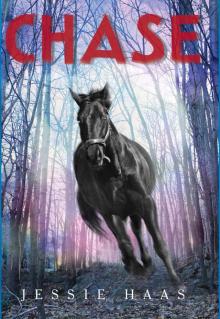 Chase
Chase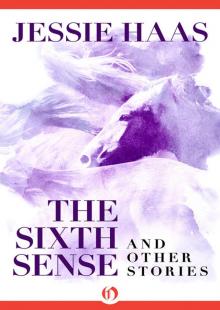 The Sixth Sense
The Sixth Sense Skipping School
Skipping School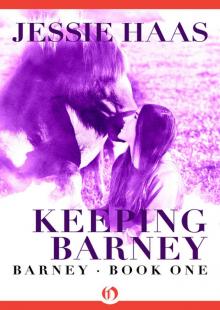 Keeping Barney
Keeping Barney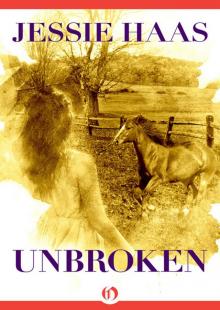 Unbroken
Unbroken Westminster West
Westminster West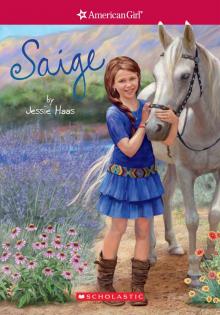 Saige
Saige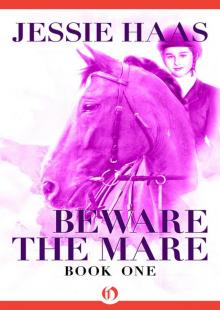 Beware the Mare
Beware the Mare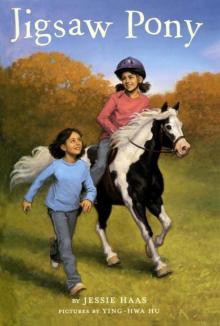 Jigsaw Pony
Jigsaw Pony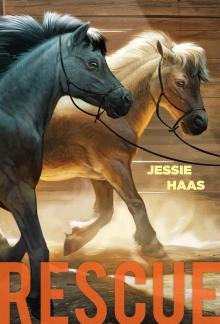 Rescue
Rescue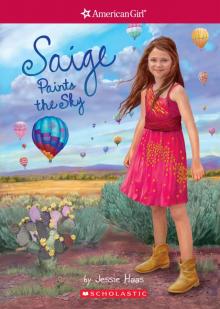 Saige Paints the Sky
Saige Paints the Sky Beware and Stogie
Beware and Stogie Chico's Challenge
Chico's Challenge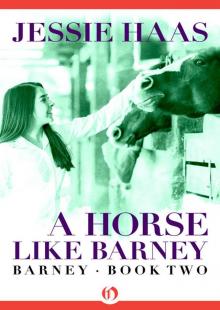 A Horse like Barney
A Horse like Barney Shaper
Shaper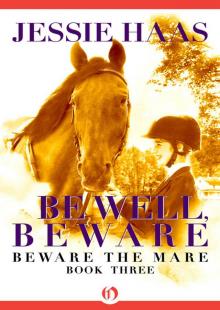 Be Well, Beware
Be Well, Beware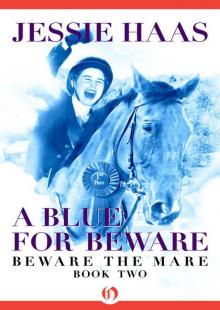 A Blue for Beware
A Blue for Beware Uncle Daney's Way
Uncle Daney's Way